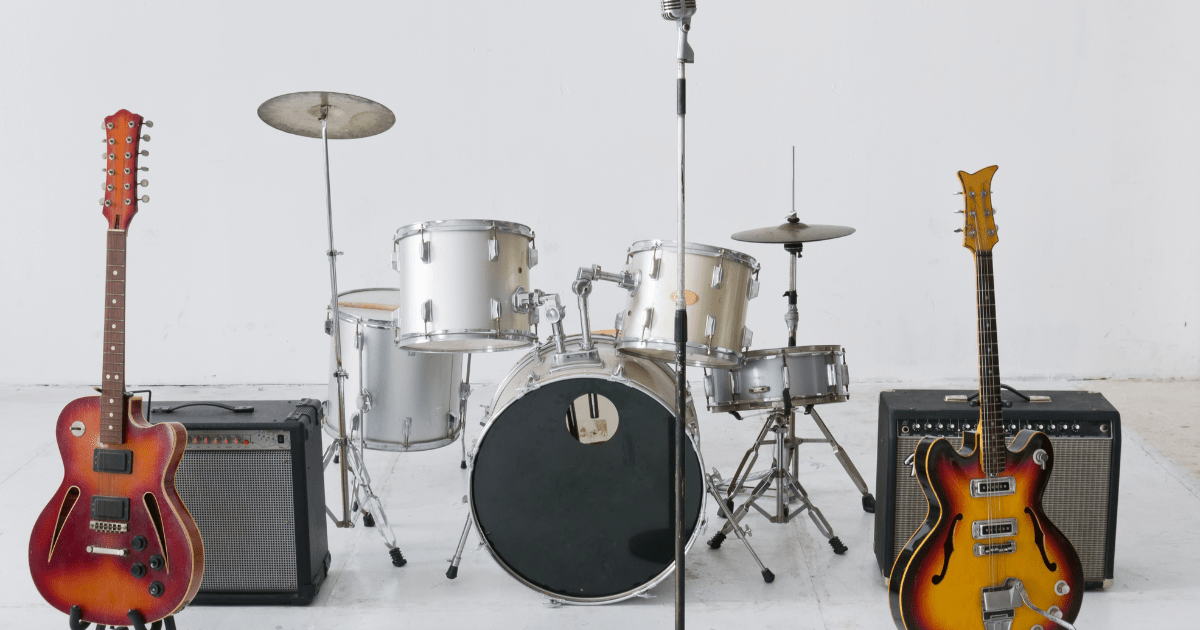Have you ever considered taking up an instrument but thought it might be too difficult? The good news is that beginners can learn how play some instruments with more ease than others.
This article about the easiest musical instruments to learn is your guide to the easiest instruments out there, perfect for anyone keen to start making music without a big struggle!
Learning an instrument can be one of the most rewarding experiences in life. It’s exciting to pick up an instrument for the first time, and the musical abilities you acquire are lifelong. Whatever instrument you choose to study, it will undoubtedly improve your life.

However the first thing to do is identifying the most appropriate instrument for your circumstances. There are other things to consider while selecting an instrument to play, even with the abundance of simple instruments available for you to learn.
The question now is, “What instrument should I play?” or if you’d prefer to weigh your options before making a decision, you’re in the right place!
How to choose which instruments to learn
The decision of which instrument to learn is frequently influenced by a number of different circumstances:
- Cost: First, think about the associated costs. Certain instruments are ideal for individuals on a tight budget, such as the recorder or ukulele, which are reasonably priced. Others, like guitars or pianos, could need a bigger upfront payment.
- Skills: Next, consider your skills and strengths. Which instrument do you prefer to play—keys, percussion, or strings? Your instincts can help you choose a tool that best suits your abilities, which will facilitate learning.
- Space: Think about the physical demands of playing an instrument. For example, not everyone can accommodate the size and weight of an instrument like a drum kit or piano, particularly if they have limited room or need to be portable. However, smaller instruments are more manageable and portable, such as the ukulele or harmonica.
- Objectives: Your objectives are also very important. The guitar or drums might be a good fit for you if you want to play in a band, but a keyboard might be more useful for writing music.
- Passion: Finally, and maybe most significantly, think about your passion. Your choice of instrument should have a personal meaning for you. Choosing an instrument that sparks your interest, whether it be the rhythmic beats of the bongos or the calming tones of the harmonica, guarantees a fruitful and delightful learning experience.
Now let’s have a look at the easiest instruments that you can choose from:
The 10 Easiest Musical Instruments to Learn
1. Ukulele
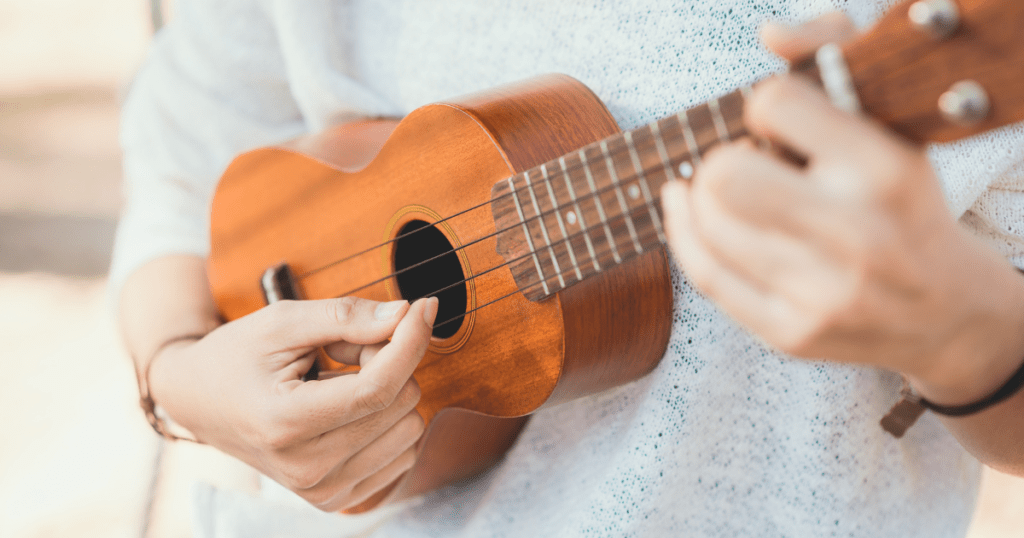
For a variety of reasons, the ukulele frequently stands out as one of the simplest instruments to learn. Let’s see why:
– Approachable: It’s approachable because to its small size and light weight. The ukulele contains merely four nylon strings, which are gentler on the fingers than the steel strings on a guitar, in contrast to many other stringed instruments. This feature greatly lessens the soreness in the fingers of beginners, enabling them to practice for longer periods of time.
– Less Chords: The ukulele only requires a small amount of chords to play a broad variety of tunes due to its relatively simple chord structures. Basic chords like C, G, F, and Am are easy for beginners to pick up quickly, enabling them to strum along to many well-known songs in no time. Because a ukulele’s fretboard is smaller than a guitar’s, people with smaller hands or less dexterity may find it easier to grasp and switch between chords.
– Forgiving attitude: Its forgiving attitude is another factor contributing to its ease of learning. The ukulele often sounds good even if you’re not hitting the correct chord, which helps discourage beginners. The straightforward melodies and lively sound of the instrument add to the overall delight of learning and inspire beginners to keep honing their skills.
- Online resources: There are a ton of beginner-friendly resources, chord charts, and online lessons accessible, and the ukulele community is quite welcoming. ArtistWorks is our favourite resource where you can learn from the master musicians.
2. Piano/Keyboard

The piano is known for having a relatively easy learning curve because of its simple design and ease of use, that’s why it’s considered of the easiest instruments to learn. Let’s see why in more detail:
– Layout:Its layout is simple and straightforward. Compared to certain other instruments, beginners can more readily master basic music theory concepts like scales and intervals thanks to the easy-to-understand layout of the keys.
–Visuals: The piano provides a visual representation of notes, which facilitates understanding the relationship between various pitches. The piano’s keys offer a direct and easy way to perceive and play individual notes, unlike other instruments where it could be difficult to do so. The piano can generate sound instantly; just push a key to hear a note be produced. Beginners are encouraged and the learning process is made more interesting by this immediate feedback.
– Quick learning: You can pick up basic piano melodies really quickly. You can perform familiar songs even as a beginner, which can be a great inspiration for more practice and advancement.
– Online and technological resources: With the introduction of digital keyboards, many now have built-in tutorials, interactive learning programs, and a variety of sounds. There are also many online resources to help you learn, like Artist Works
3. Recorder
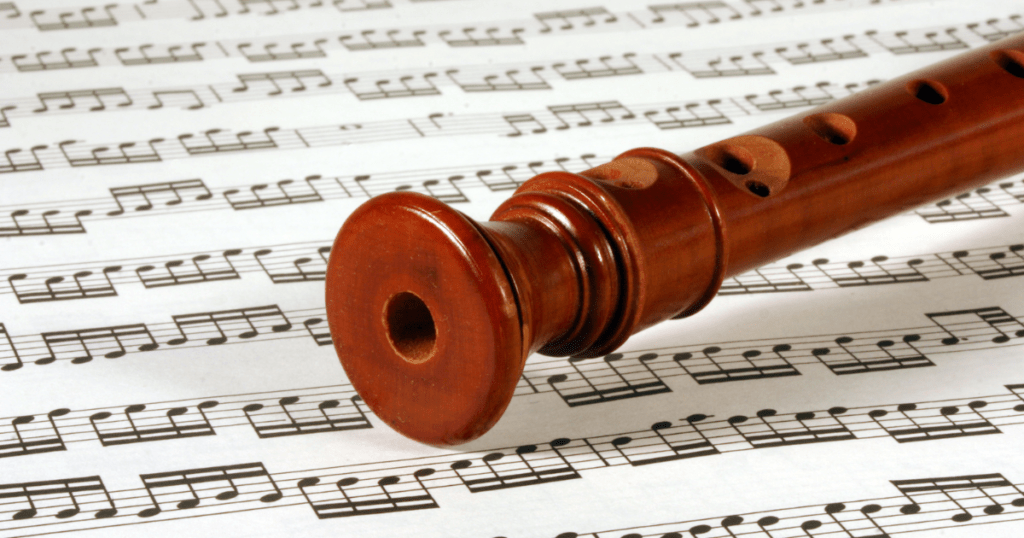
The recorder is one of the simplest instruments to learn and it’s a great option for beginners. Its straightforward fingering and simple melodies make it a great starting point for music education.
– Design: The recorder’s simple mouthpiece and limited finger holes let beginners concentrate on taking clean notes instead of worrying about complicated finger placements.The small size of the recorder is also helpful for new users, particularly younger students. Its lightweight and mobility make it simple to use, promoting frequent practice without putting a burden on the body.
– Straightforward approach: The recorder is a wind instrument with a basic mechanism for producing sound. To produce different notes, players cover certain finger holes and blow into the mouthpiece. Beginners will find it easier to comprehend the relationship between finger movements and musical tones with this simple technique.
Beginners can concentrate on learning a smaller selection of notes before progressing to more intricate musical compositions because of the recorder’s restricted range.
4. Drums

Drums provide a distinctive and compelling way to begin playing music. Beginners can learn simple beats quite quickly due to their natural rhythmic quality. Drums are more intuitive for certain people because they primarily focus on rhythm, unlike many melodic instruments that require learning precise pitches or notes.
– Tactile learning process: Beginners can directly link their physical actions to the sound produced since they can feel the beats as they hit the drums. This tactile feedback encourages experiential learning, which can be especially fulfilling and interesting.
– Quick learning: Simple drum patterns are easy to pick up and use quickly, giving newbies a solid starting point. Compared to some other instruments, beginners can start playing along with songs sooner thanks to simple rock beats and basic jazz rhythms. Drums provide a feeling of instant gratification. Drummers may create pleasing sounds even with limited experience, which inspires newbies to keep learning and developing their skills.
– Versatility: A basic setup consisting of a snare, kick drum, hi-hat, and cymbals can be used by beginners, who can add extra parts as their skills improve. With this methodical technique, they can increase the scope of their repertoire without becoming overly complex.
5. Guitar
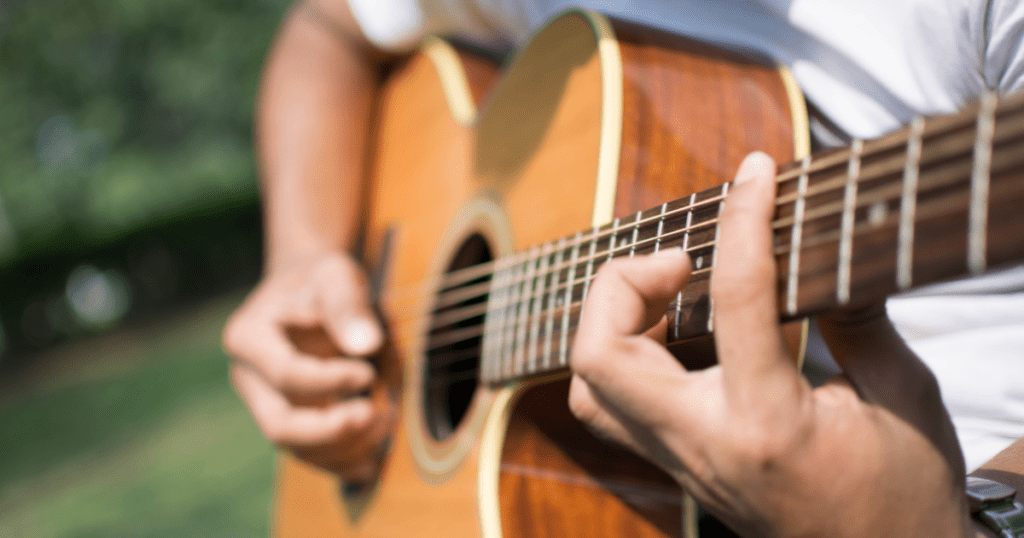
The guitar is well known for being a beginner-friendly instrument that offers just the right amount of difficulty and accessibility. While mastering it can take time, learning basic chords and strumming patterns is manageable for beginners.
– Easy chords and patterns: Beginners may learn the fundamental chords and strumming patterns of the guitar quite easily. Acquiring knowledge of basic chords such as G, C, D, and E minor, among others, enables beginners to perform an extensive repertoire. Acquiring familiar songs quickly inspires novices to keep learning and developing their abilities.
– Visual learning: The fretboard configuration of the guitar makes it easy for beginners to see the notes and chords. The guitar’s frets and strings provide a clear picture of where to position fingers for different notes and chords, which helps in learning as opposed to instruments whose notes are less physically visible.
– Wide range of musical genres: The guitar’s versatility in terms of musical genres is another benefit. Any genre can be played on the guitar thanks to its versatility, including pop, rock, folk, and blues. This adaptability gives novices the opportunity to experiment and discover their favorite musical niche.
– Online resources: The availability of internet tutorials, chord diagrams, and instructional videos has increased accessibility to guitar study. These tools allow learners to study at their own pace by providing practice exercises and step-by-step instructions.
6. Harmonica

The harmonica offers a great introduction to music for beginners.
– Ease of producing sounds: Its small size and few notes contribute to its simplicity. The harmonica, in contrast to many other instruments, requires little finger dexterity because it is played primarily with the mouth and breath control. Its ease of sound production is one of its primary benefits. Newbies can produce basic tunes by inhaling into the instrument for a few breaths. Beginners are encouraged to try and learn more about the instrument by this quick satisfaction.
– Design: The harmonica’s design makes learning easier. It usually has a designated key, which makes learning several notes and scales less difficult. The learning curve can be accelerated for beginners by having them concentrate on mastering one harmonica key before moving on to others.
– Portability: It’s a handy instrument to practice anyplace because of its portability. Because of its compact size, even beginners may use it, which encourages regular practice and progress.
– Different genres: Because the harmonica is used in so many different musical genres, such as rock, folk, country, and blues, beginners have a wide range of styles to choose from. Because of its adaptability, novices can try out various genres and discover their favorite music.
7. Xylophone
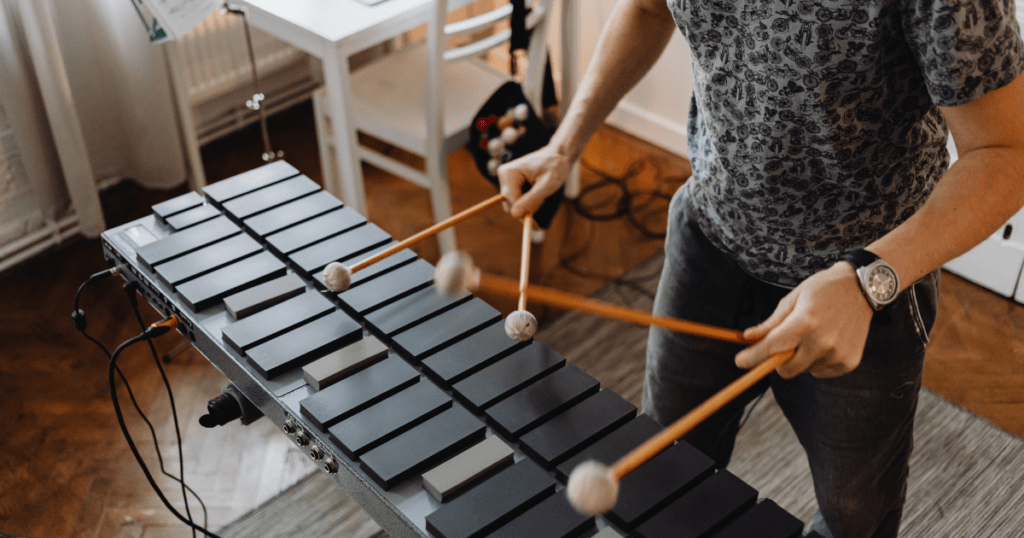
The xylophone’s straightforward layout and easy-to-learn arrangement make it a particularly good instrument for beginners.
– Design:Its simple bar arrangement makes it simple for beginners to comprehend and play melodies by giving them a visual representation of the notes.
– Basic learning: A few mallets and a basic comprehension of striking the bars are all that are needed for beginners to generate pleasing sounds that provide instant gratification.
– Range of notes: The xylophone’s narrow note range makes learning easier and lets beginners concentrate on learning simple melodies before moving on to more difficult songs.
Due to its simplicity, it is the perfect instrument for both adults and children to learn about rhythm and melody in a fun and approachable way.
8. Bongos

Basic rhythms are easy to learn, and they offer an accessible entry point into percussion.
– Simplicity: Their simplicity can be attributed to the simple hand drumming method used to generate sounds. Beginners can begin generating rhythmic patterns almost immediately with just two drums: the bigger “hembra” and the smaller “macho”.
– Design: Because of the bongos’ simple design, beginners can experiment with different striking methods and hand placements to create a variety of rhythms and tones.
– Size: The bongos’ small, lightweight design makes them simple to carry and practice anyplace, giving novices a practical method to explore the world of percussion.
The instant accessibility and rhythmic appeal of the bongos make them an enticing option for novices keen to get into percussion and beats, even though mastering more complex rhythms and skills may take some time.
9. Tambourine
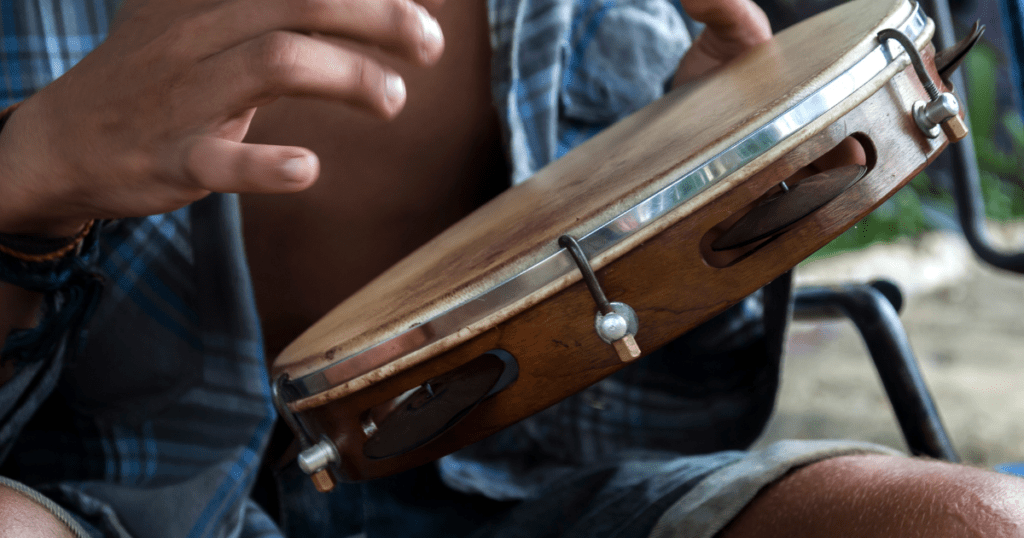
When it comes to percussion instruments, the tambourine is a great place for novices to start because of its straightforward yet catchy jingle.
– Design: Its simple design, with a circular frame and metal jingles (sometimes called “zils”), makes it instantly accessible to beginners. To create the tambourine’s distinctive jingling sound, the basic playing technique is to shake, tap, or strike the instrument. Novices can quickly experience a sensation of instant fulfillment by experimenting with different hand movements and rhythms.
– Size: Because it is portable and lightweight, both kids and adults can easily experiment with rhythm and accompaniment with this instrument. Although it may take some time to learn more difficult tambourine techniques, including rolls or complicated rhythms, its simplicity and capacity to bring joy to music make it an
10. Kalimba/Thumb Piano
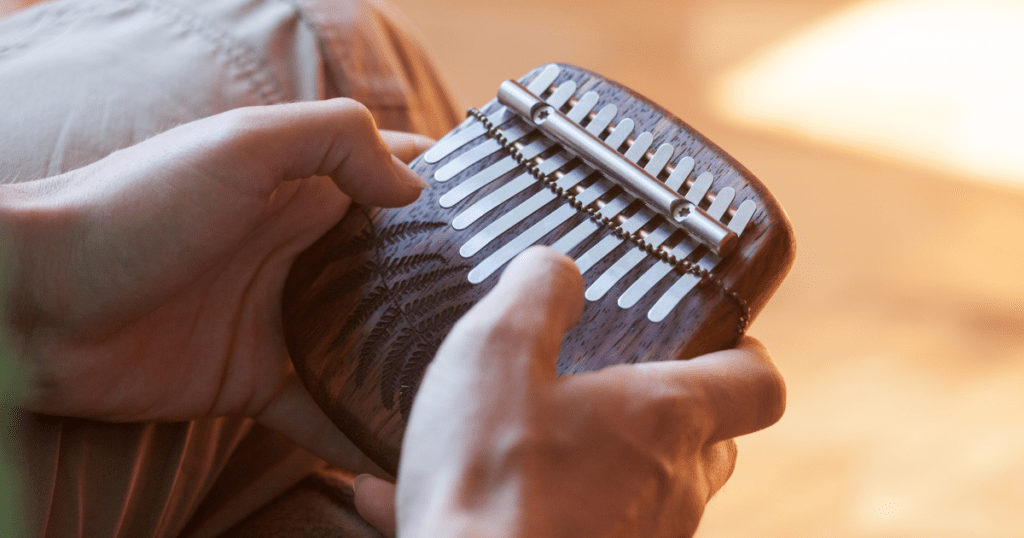
Beginners are drawn to the Kalimba, sometimes referred to as the thumb piano, by its endearing sound and alluring simplicity.
Its construction, which consists of metal tines fastened to a resonant body, makes plucking with the thumbs or fingers simple. By pressing the tines, beginners may easily create melodies and produce attractive tones quickly. With just a few tines, the Kalimba’s simplistic design makes learning easy and even beginners can quickly pick up basic melodies. Because of its small size and portability, it’s an ideal instrument for novices to experiment with music anywhere, encouraging regular practice.
Advice for Becoming a Master of Your Instrument
Whatever instrument you ultimately decide on, mastering it will always come down to establishing a solid practice schedule with enjoyable, user-friendly materials. It is just as crucial to comprehend how to continuously advance and maintain focus during the learning process as it is to select the right instrument.
Here are our tips:
- Pick the instrument that suits you the best. Choosing the appropriate instrument for you is essential to persevering through the process and appreciating even the most monotonous aspects of learning.
- Create a practice timetable. Even if there are a lot of simple instruments to learn, it will take time to become an expert. Since practicing at least a little bit every day is the only way to get good, make sure to schedule practice time and adhere to it.
- Look into classes and lessons, online or in person. The study of music is a broad topic that includes performance, technique, theory, and many other facets. Seeking out music instruction that can keep you on track is a fantastic option to help make sense of it all and monitor your progress. A great online resource is ArtistWorks.
Final thoughts
In conclusion, all of these instruments—from the upbeat ukulele to the rhythmic bongos—welcome newcomers who want to explore the world of music. Every instrument has a certain allure, regardless of whether one is motivated by cost, enthusiasm, or ease of learning. The joyous jingle of the tambourine, the mellow tones of the Kalimba, and the straightforward melodies of the xylophone all entice beginners to explore music in a fun and approachable way. These instruments become friends in a rewarding journey of discovery and development, in addition to serving as portals for musical expression. They make sure that everyone, regardless of age, may discover joy and rhythm in the world of music with their charm and ease.
YOU MIGHT ALSO LIKE
- Best Kalimba Songs
- Epic Walkout Jams
- Songs About Stars
- Best Stripper Songs
- Songs About Growing Up
- Best Songs About California
- Best Songs About Flying and Planes
- Best Songs About Money
A music enthusiast who has taken his passion for music to the next level by starting his own blog. He spends most of his free time listening to new albums, attending concerts, and researching emerging artists.
What sets John apart from other music bloggers is his ability to connect with his readers on a personal level. His writing style is warm and engaging, making it easy for readers to relate to him as both a fellow music lover and someone who truly cares about the art form.
John’s love for music started at a young age when he discovered classic rock through his father’s vinyl collection. Since then, he has expanded his musical horizons to include everything from indie rock to hip hop and beyond.
As a blogger, John has found a way to share his love of music with others while also providing valuable insights into the industry.

